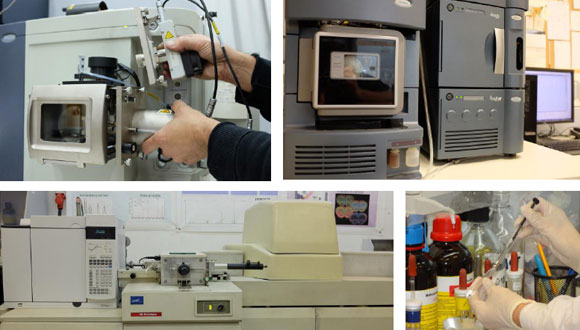About the Mass-Spectroscopy Lab
At the beginning
During the early years of the Chemistry Department, the only instruments available to researchers were UV, IR and later, NMR spectrometers. Mass spectrometers were rare and the identification of reaction products was usually determined by elemental analysis. Samples for analysis were sent to the Hebrew University or to laboratories in Germany or Sweden, a process involving a wait of several weeks for results. At the beginning of the ‘70s, it was decided to set up a mass-spectrometry laboratory in the Chemistry Department in order to provide service to researchers in chemistry and the life sciences.
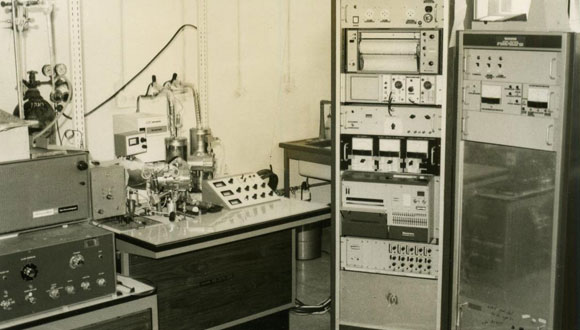
The first mass spectrometer in the School of Chemistry, Tel Aviv University, 1970s. (photograph: TAU)
The first mass spectrometer was acquired in 1972. Since, for budgetary reasons, a high-resolution instrument was too expensive, a medium-resolution mass spectrometer was obtained. Shimon Hauptmann who, up to then, was involved in organic synthesis for several research groups, entered this new field and began setting up the laboratory.
Dupont 21-491B (operated from 1973 to 1994)
This instrument, in EB configuration, (electrostatic focus unit followed by a magnetic unit), was developed by Dupont CEC (Consolidated Engineering Corporation). Its ion source was operated on EI and CI modes. Since the instrument was entirely analog, all systems (vacuum system, power supplies, temperatures, etc), were controlled by the operator.
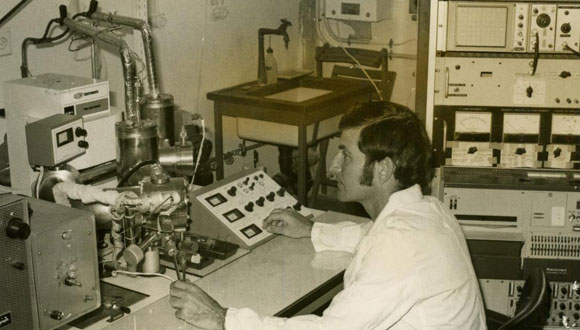
Shimon Hauptmann in the laboratory, 1975 (photograph: TAU)
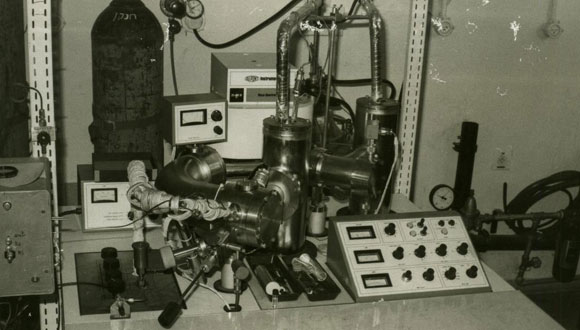
Part of the instrument, mid-1970s, (photograph: TAU)
A sample of the substance to be analyzed is vaporized and ionized. The ions obtained are focused to a beam by an electric field, passed to a magnetic field (an electromagnet) which scans the range of mass to be measured. At the end of the trajectory, an electron multiplier converts the ion current to an electrical current. The output is measured by a UV oscillograph – which contains a wire under tension with a mirror attached. The current causes distortion of the wire and accompanying movement of the mirror according to the current. The light of a xenon lamp is reflected by the mirror and is focused on photographic paper where the results are recorded on an exponential scale. Finally, the lines obtained on the photographic paper are decoded with the help of a logarithmic ruler and converted to masses.
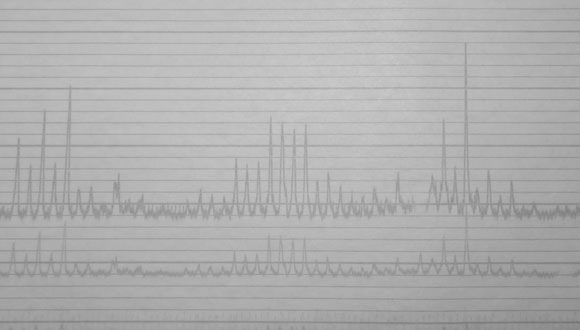
Mass spectrum on photographic paper
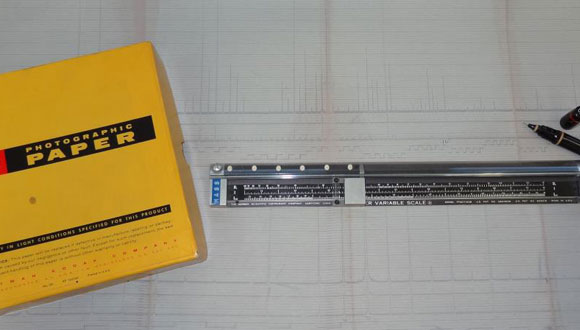
Decoding of the spectrum with the help of a logarithmic mass ruler. On the left, a box of Kodak photographic paper.
Over the years, the spectrometer underwent many upgrades: Shimon added calibration methods, automatic methods for adding liquid nitrogen to the cryogenic vacuum system and temperature-control systems, among others. After some years, with the development of GC technology, a Tricor GC instrument was obtained and connected to the mass spectrometer. In addition, a Jet separator was used to remove most of the helium.
With the advances in electronics and the appearance of microprocessors, a project was initiated to develop a system of computerized data processing with dedicated hardware and software. (The system was developed with the electronics laboratory of the School of Chemistry).
In June 1985, the first upgrade was completed and following this, a further upgrade was carried out. For nine years, the original instrument was operated with a modern data-processing system. In May 1994, after 21 years of operation, the mass spectrometer was retired and its place was taken by a modern instrument.
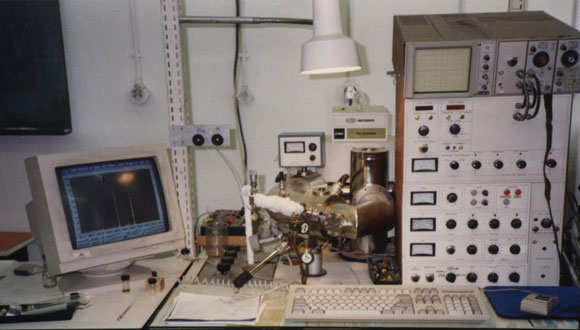
The spectrometer, after upgrading and computerization. Late 1980s. (Photograph: Shimon Hauptmann)
VG Autospec M250 Q (since May 1994)
22 years after obtaining the first mass spectrometer, the laboratory acquired and set up a modern, sophisticated instrument made by VG Micromass. The instrument is based on two electrostatic units, and between them an electromagnet capable of reaching a mass of 5000 and a quadrupole for MS/MS measurements. The resolution of the instrument can be adjusted up to about 20000 for HRMS analyses. The ion source is modular in order to enable rapid switching between the different ionization methods (EI, CI, FAB) and connecting the mass spectrometer to GC. Data processing and operation of the instrument are computerized by the Opus software running on an alpha computer and a data base for comparison of spectra. The instrument considerably upgraded the abilities of the laboratory and enabled high-resolution measurements and the investigation of polar substances and materials of high mass and even proteins by the ESI method, which at the time was in its infancy. In 2010, the instrument was upgraded: the Quad unit was removed and the GC and computerized system replaced.
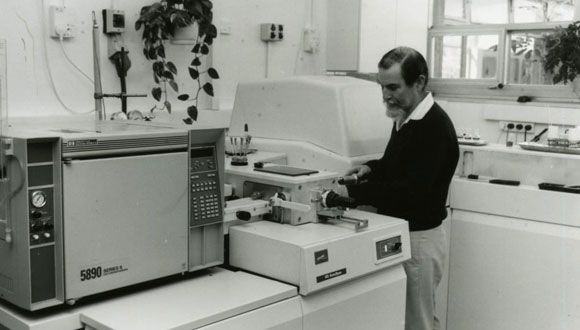
VG Autospec. Mid 1990s. (Photograph: TAU)
LCMS-MALDI-SYNAPT (since September 2009)
The system includes a Q-TOF mass spectrometer and UPLC, both made by Waters. Thanks to the modular structure of the ion source, it is possible, in minutes, to move between a number of ionization methods: ASAP, APPI, APCI, ESI. Since working with MALDI requires venting the instrument, this method is used only when a sufficient number of samples has accumulated.
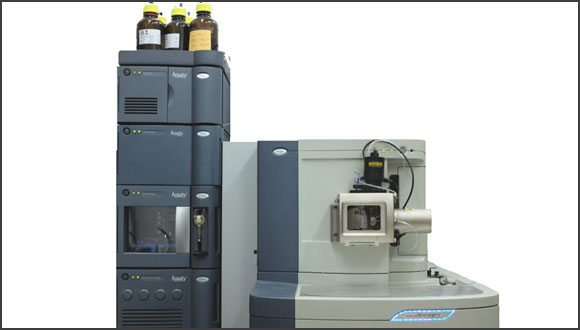
Acquity MALDI SYNAPT (Photograph: Anatoly Rotman)
The combination of high resolution and mass accuracy enables accurate mass measurement and determination of the empirical formula up to masses of about 4000 daltons. In addition, it is possible to carry out MS/MS measurements with the use of all ionization methods and to include chromatographic separations with a variety of columns.
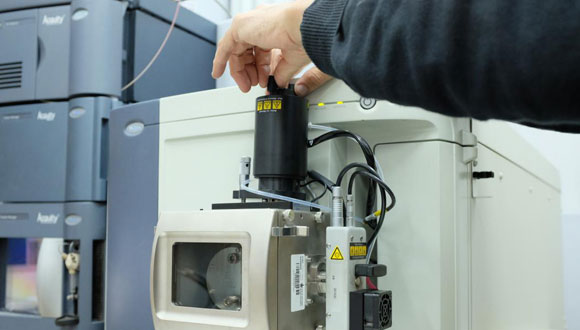
Connection of APPI source to SYNAPT (Photograph: Anatoly Rotman)
LTQ Fleet (2010-2011)
In 2010, Tel Aviv University Center for Nanoscience and Nanotechnology acquired a Thermo Company ion-trap mass spectrometer combined with LC, for the use of research students, for simple analyses. The instrument was transferred to the mass-spectrometry laboratory and was set up with other equipment. Unfortunately, the LTQ had a “brief life”. During a thunderstorm several months after it was connected, fire broke out in the laboratory and destroyed everything in it.
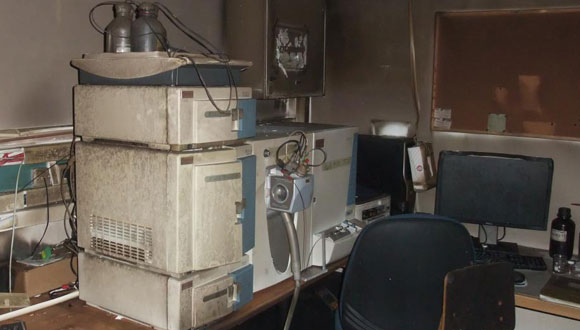
The LCQ fleet the day after the fire. (Photograph: Noam Tal)
LCMS Xevo–TQD (Since September 2012)
This instrument was acquired after its predecessor was destroyed in the fire. It comprises a Waters Company LCMS system which includes an Acquity model UPLC and a Triple Quad mass spectrometer. The system is set up for use by research students and anyone with a basic knowledge of mass spectrometry. Operation of the TQD is possible after a short course of instruction. Most of the operation is automatic with no necessity of adjustment or calibration.
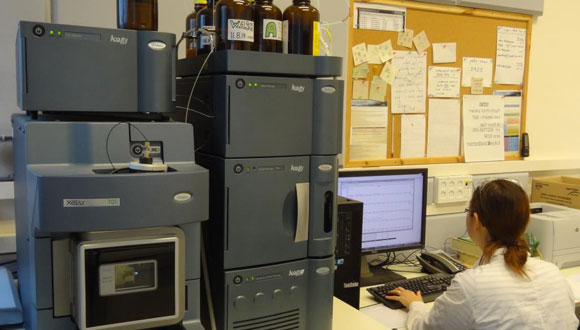
The LCMS system (Acquity-TQD) (Photograph: Noam Tal)
MALDI Autoflex
Over the last few years, there has been an increase in the need for measurements on high-molecular-weight substances, like dendrimers, oligomers, polymers and proteins. In order to analyze these substances, it is necessary to have a linear MALDI spectrometer with a mass range greater than 200000 daltons and programming suitable for the processing of the data.
Dr. Roey Amir of the School of Chemistry is engaged in efforts to acquire a MALDI spectrometer which will enable analysis of these substances.
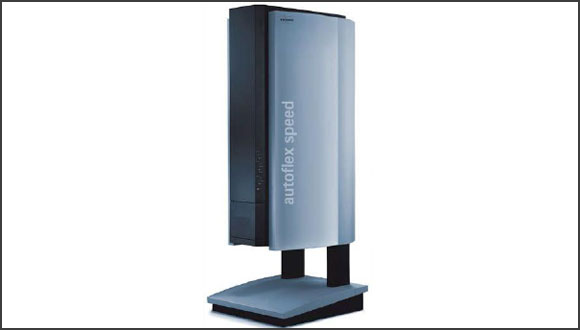
Summary
In this review, we have described the development of the mass-spectrometry laboratory at the University of Tel Aviv, from the beginning, at a time when the operation of a mass spectrometer was complicated and required considerable skill and knowledge, up to the present, when some of the analyses are carried out by students who have been given basic instruction.
The mass-spectrometry laboratory at the School of Chemistry provides service to all research workers in Tel Aviv University and is open to visitors from all parts of the campus (by appointment).
Furthermore, we take part in the program “The Wonders of Chemistry”, held in the laboratories of the School of Chemistry. This program is attended every year by hundreds of young secondary-school students who are studying chemistry and physics. Its purpose is to encourage both the development of scientific thought and the choice of science and technology as a career.
